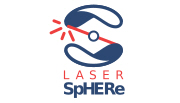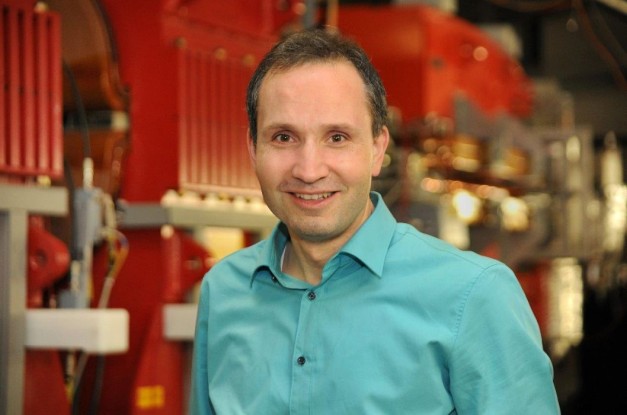Open Positions
We always look for new highly motivated members of our working group to perform laser spectroscopy experiments at TU Darmstadt, the storage rings and trap facilities at the GSI Helmholtz Centre for Heavy Ion Research, at ISOLDE/CERN and at Argonne (USA). We offer all stages of education from mini-research, bachelor and master thesis up to PhD contracts. Please contact any member of the working group if you are interested.
The presentation (in German) of “Attraktive Physik” in WS 21/22 can be found here: pdf, 4.1 MB (opens in new tab)
A list of the theses that have been successfully finished in our working group can be found here .
Upon request, we are happy to involve you in our current research. We offer a variety of different projects, some of which are available on short notice.
Contact person:
Optics: Julien Spahn – jspahn@ikp.tu-…
Atomic physics: Hendrik Bodnar – hbodnar@ikp.tu-…
Nuclear physics: Julian Palmes – jpalmes@ikp.tu-…
and all other members of the working group
.
Bachelor Theses
The scattered laser light is the primary background source in the collinear laser spectroscopy measurements at the COALA lab. This light originates from the apertures within the vacuum system and can be minimized through precise adjustment of the laser beam position.
Goal: The optimization of the laser background will be automated as part of this project using two motorized mirrors. To achieve this, the automated mirrors must be installed, and an optimization software needs to be developed.
Contact person: Julien Spahn (S2|14 22, jspahn@ikp.tu-…)
The Calcium-Nickel region is an interesting field of nuclear physics research due to the many shell closures at N & Z = 20 & 28. With collinear laser spectroscopy, nuclear charge radii of different isotopes can be determined. For example, at the N = 28 and Z = 28 shell closure, a strong change in the nuclear radius was observed: the magic isotopes are significantly smaller than their neighbors. At N = 20, however, a continuous trend was observed. New measurements in Sc, however, also show a local minimum here. To expand the measurements in this region, measurements on Cr+ and Co+ at the Facility for Rare Isotope Beams (FRIB) in the USA are planned.
Goal: Preparatory measurements will be conducted at the COALA facility in Darmstadt, where the optical transitions will be determined with the highest accuracy. Both Cr+ (207 nm) and Co+ (206 nm) transitions are in the deep UV range and thus require a complex laser system. Several possible transitions will be compared to identify the most suitable one. All stable isotopes of Cr+ will be measured, and a King-fit analysis will be performed.
Contact person: Imke Lopp (S2|14 22, ilopp@ikp.tu-…)

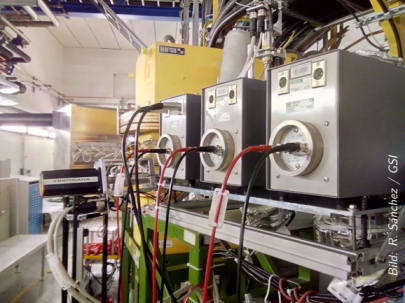
At Cryring, ions can be studied spectroscopically in the storage ring at relatively low energies. For the analysis of the acquired spectra, the used laser power is a critical component. This can fluctuate during the experiment and lead to artifacts in the recorded spectra.
Goal: In this project, a system of photodiodes will be implemented to register relative fluctuations in laser power. The photodiodes need to be tested, and especially the background noise and drifts need to be characterized. The generated signal must then be processed and written into the data acquisition system.
Contact person: Konstantin Mohr (GSI, k.mohr@gsi.de)
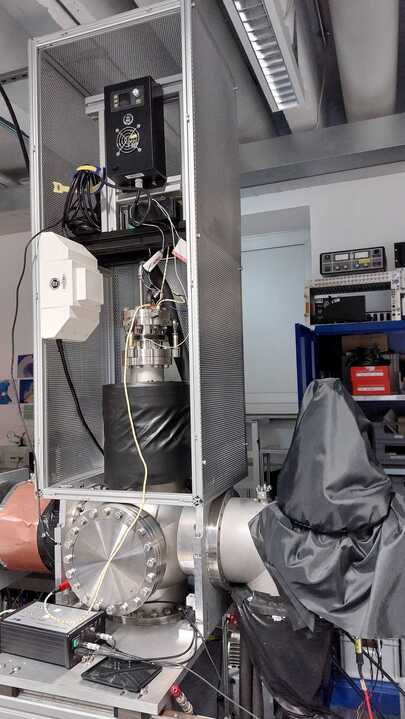
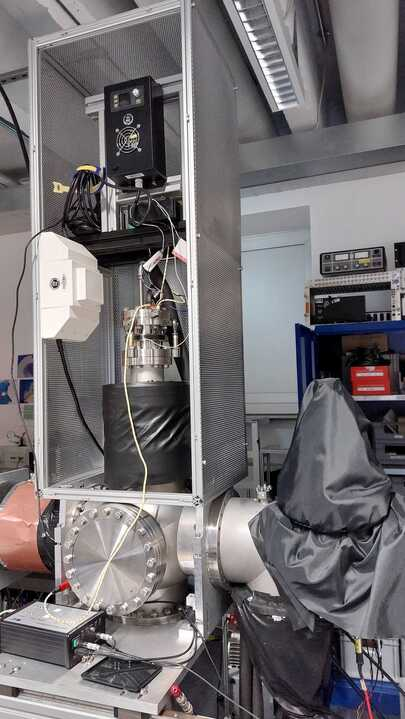
In the new charge exchange cell at COALA, ions in flight can capture electrons from a sodium gas. This is essential for collinear laser spectroscopy, as optical transitions from the ionic ground state that can be excited with the available laser systems are only present in some elements. In atomic systems, there are generally more transitions in the visible range. While the charge exchange from singly charged ions to neutral atoms is widely used at many facilities worldwide, the charge exchange of highly charged ions has been less studied. This could enable new measurement schemes, as some elements, e.g., the lanthanides, are preferentially produced in a doubly charged state.
Goal: This bachelor thesis will investigate the charge exchange efficiency of highly charged ions that can be produced in the EBIS ion source. The sodium vapor pressure will be optimized through the temperature of the charge exchange cell to populate targeted charge states. Of particular interest is the efficiency of a one-electron transfer for highly charged ions. This would allow the metastable 3S1 state in helium-like C4+ ions to be populated, which is needed for laser spectroscopy measurements.
Contact person: Emily Burbach (S2|14 503, eburbach@ikp.tu-…)
For neutron number N = 94, nuclear spectroscopy data that evaluates the B(E2) value suggest a strong increase in quadrupole deformation for cerium (Z = 58) while neodymium (Z = 60) shows the opposite: a steep drop in the correlated β2 value, which inverts the trend between the two elements. Collinear laser spectroscopy is highly sensitive to changes in nuclear charge radius, which is typically parameterized by a spherical part according to the droplet model and a deformation part which directly relates to all deformation parameters β. The changes suggested by the respective B(E2) values are large enough to even invert the trend in nuclear charge radii. Neutron rich cerium and neodymium isotopes can be produced in NuCARIBU at Argonne National Laboratory (USA), where online measurements are planned.
Goal: At COALA at TU Darmstadt measurements in stable Ce+ and Nd+ isotopes can be performed. First, the most suitable excitation scheme will be developed, which allows for efficient laser spectroscopy at well resolved hyperfine spectra. Ce offers four and Nd seven natural abundant isotopes, which will be investigated to determine the mass- and field shift parameters with highest precision. Those are required for the determination of the charge radii of the short-lived isotopes from the planned isotope shift measurements at ANL.
Contact: Julian Palmes (S2|14 22, jpalmes@ikp.tu-…)
Master Theses
Measurements in the Calcium-Nickel region have been a research focus of collinear laser spectroscopy in recent years. The three doubly-magic nuclei (40,48Ca, 56Ni) and the significantly different effects of neutron shell closures at N=20 and N=28 on the nuclear charge radius provide optimal test conditions for theory and experiment. Neutron-poor iron is a candidate for future measurements at the Facility for Rare Isotope Beams (FRIB), where additional nuclear deformations are expected.
Goal: The aim of this work is to investigate an efficient spectroscopy transition in the singly charged iron ion. This would significantly improve efficiency compared to previous measurements on the iron atom. Possible transitions are in the deep UV range at 234.3 nm, 238.2 nm, and 259.9 nm. The stable isotopes 54,56,57,58Fe can be produced and spectroscopically studied at the COALA facility at TU Darmstadt with a new Penning ion source. These measurements will serve as the foundation and reference for later measurements at FRIB.
Contact person: Imke Lopp (S2|14 22, ilopp@ikp.tu-…)
Commercially tunable cw laser systems are available up to a wavelength of about 200 nm. Shorter wavelengths present challenges, but extending the range to 190 nm would enable many new applications, such as laser spectroscopy in N5+ or Ti+.
Goal: In collaboration with Sirah Lasertechnik GmbH, a laser system consisting of a Matisse and two Wavetrains will be developed to generate UV light in the 190 – 200 nm range. The impact on optics and the doubling crystal will be examined in the laser company's lab, and solutions will be worked on with the technicians on-site. A major portion of the master’s thesis will take place at Sirah Lasertechnik GmbH (in Grevenbroich near Düsseldorf), and accommodation will be provided. The laser will then be used at COALA for collinear laser spectroscopy measurements in Ti+.
Contact person: Julien Spahn (S2|14 22, jspahn@ikp.tu-…)
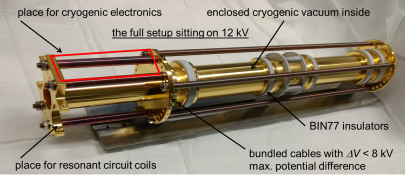
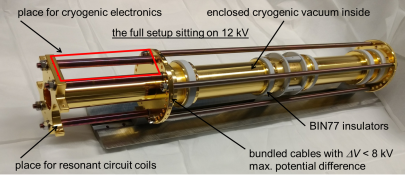
Heavy highly charged ions are unique test objects for studying quantum electrodynamics under extreme conditions. For example, the magnetic fields acting on the remaining electron in a hydrogen-like system in Bi82+ far exceed the fields that can be generated with superconducting magnets. Such highly charged ions can be produced at accelerator facilities at high energies but must then be decelerated and cooled to enable precision measurements. Recently, electron cooling of highly charged ions in the HITRAP Penning trap at GSI was demonstrated, where the ions were stored together with the electrons.
Goal: This master’s thesis will further investigate the electron cooling of ions from the HITRAP-EBIT ion source and the extraction and detection of the cooled ions, as well as prepare for upcoming experiments with GSI beams.
Contact person: Zoran Andelkovic (GSI, z.andjelkovic@gsi.de)
The collinear laser spectroscopy facility COALA at TU Darmstadt was developed to enable measurements with the highest precision. One application goal is the development of a quantum standard for high voltage measurements. High voltages (>1000 V) can currently only be measured using conventional voltage dividers, consisting of chains of classical resistors. Using collinear laser spectroscopy, a voltage applied to accelerate ions can be traced back to a (laser) frequency measurement due to the Doppler effect. With the frequency comb available at COALA, the laser frequency can be linked to the atomic clock frequency to define a quantum standard.
Goal: In previous measurements (https://iopscience.iop.org/article/10.1088/1681-7575/aaabe0), a relative accuracy of 5E-6 was achieved. The main limitation was the design of the post-acceleration section. The corresponding electrodes have been optimized and will be integrated into the COALA beamline as part of this project. High voltage measurements will first be conducted with Ca+ ions and later with highly charged C4+ ions.
Contact person: Hendrik Bodnar (S2|14 22, hbodnar@ikp.tu-…)
A Multi-Reflection Time-of-Flight (MR-ToF) spectrometer consists of two electrostatic mirrors between which ion packets can be stored. These ion packets can complete several thousand orbits in the MR-ToF and travel long distances. This allows the separation and high-precision measurement of masses based on different flight times or the generation of an isobarically pure ion beam. Another application is the simultaneous storage of multiple isotopes, which can then be released in quick succession. The application of this method at accelerator facilities could significantly increase their efficiency, as currently only single isotopes can be measured.
Goal: Assembly and commissioning of the COALA MR-ToF, which is a copy of the MR-ToF from the Obertelli group. The trap parameters will be optimized to achieve long storage times with correspondingly high mass separation. Subsequently, the separate expulsion of various isotopes will be developed. Collinear laser spectroscopy can be performed on the separated ion packets to demonstrate this technique for use at accelerator facilities and to study the beam properties.
Contact person: Finn Köhler (S2|14 22, fkoehler@ikp.tu-…)
In external magnetic fields, the Zeeman splitting leads to an energetic separation of the magnetic states m. This results in a shift of the laser frequency required for excitation, depending on whether linear or circularly polarized light is used. Unwanted systematic shifts can occur due to existing external fields, such as the Earth's magnetic field or fields from magnetically levitated vacuum pumps. On the other hand, magnetic fields can also be applied intentionally, allowing the ion beam to be polarized for subsequent measurements.
Goal: In this master’s thesis, optical detection at COALA will be extended with a pair of Helmholtz coils to generate a homogeneous magnetic field at the location of the laser-ion interaction. The field of the coil pair will first be simulated, then fabricated, installed, and measured. The latter can be initially done using a Hall probe. Subsequently, the Zeeman splitting, for example in Ba+ ions at the COALA setup, can be spectroscopically measured. Furthermore, the Helmholtz coil pair can also be used to compensate for the Earth's magnetic field.
Contact person: Hendrik Bodnar (S2|14 22, hbodnar@ikp.tu-…)
The Spectrap experiment (situated at Hitrap at GSI, webpage) aims at performing laser spectroscopy of (hyper-)fine structure transitions in heavy, highly charge ions stored in a cryogenic Penning trap. It is currently being redesigned to fit into a new magnet. For this, several tasks are at hand, where possible Master projects can be found:
- Design the cryogenic insert around the existing Penning trap including electronics, thermal shields and laser access
- Planning and commissioning of beamline for transport of highly charged ions into the Penning trap, first experiments with ions from a local ion source
- Programming of the experiment control system in Python (in collaboration with the other experiments at HITRAP)
- Design and setup of a laser system to perform spectroscopy of ions in the trap
Contact person: Rima Schüssler (GSI, r.schuessler@gsi.de)
Laser spectroscopy on exotic ions is a well-established method to extract fundamental nuclear ground state properties. Ion beams of these exotic nuclei are generated at accelerator facilities and are then guided to the laser spectroscopy setups. In some cases, there are no available laser transitions in the ionic state, or it is otherwise advantageous to perform the spectroscopy on the atom. As atoms cannot be guided with electromagnetic steerers, the ion beam is usually transported to the spectroscopy experiment and the ions are converted to atoms locally by using so-called charge exchange cells (CEC). Well-established for these are vapor chambers filled with alkaline-metals, that due to their low ionization potentials have decent cross section for charge exchange. As the difference in the ionization potentials between the vapor and the ion of interest grows, an additional excitation of the atom of interest gets more likely and the resulting fluorescence light increases the background signal. A possible solution would be to use the same element for the vapor as the atom of interest, but vaporizing by heat is inaccessible for some elements. Thus, we want to test the possibility of creating these vapors by laser ablation.
Goal: The ultimate goal is to compare this mechanism to the well-established ones on the example of laser spectroscopy on Platinum isotopes for the possible deployment at the N=126 factory at the Argonne National Laboratory near Chicago.
Contact Person: Julian Palmes (S2|14 22, jpalmes@ikp.tu-…)


